Churches and Religion
|
St. Bartholomew’s Church There was certainly a church at
Wednesbury by the early thirteenth century because it is
recorded in the Plea Rolls of King John for 1210-1211,
that Master William, a royal chaplain had been appointed
to the church at Wednesbury.
The present St. Bartholomew’s
Church dates from the late 15th or early 16th
century and contains a pulpit carrying the date 1611.
At the west end of the nave is a
table tomb with recumbent effigies of Richard Parkes who
died in 1618, and his wife.
It has been greatly restored and rebuilt, and
stands on the site of an earlier 13th century
stone built church. |
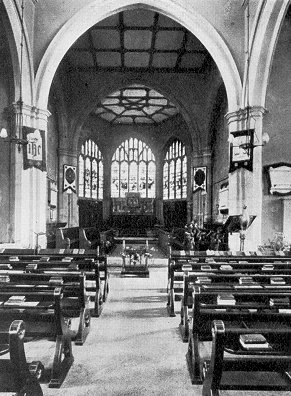
St. Bartholomew's Church. |
|
|
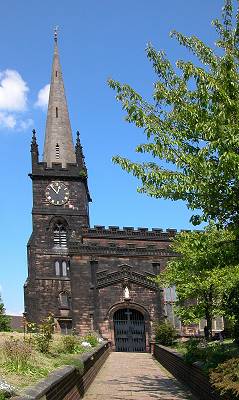
St. Bartholomew's Church. |
Remains of the
earlier church were found during restoration work in
1885 and consisted of a three light window contained in
a round-headed arch. The three lights date back to the
13th century but the
arch itself could be earlier.
The ancient window is to
be found at the west end of the north aisle. It is next
to the doorway which gives access to the choir vestry.
This has a pointed segmental arch and is said to be from
the same date as the window.
In 1757 the tower was
restored and the top 16 feet were rebuilt. At the same
time the ball and weathercock were replaced. Restoration
work continued in 1764 and 1765 when the nave roof was
repaired and a ceiling added to the nave.
Unfortunately
during the work, part of the parapet on the northern
side collapsed onto the roof and both fell onto the pews
beneath, causing serious damage. As luck would have it
the pews were empty at the time. Only an hour earlier
they had been occupied during a funeral service. |
| As the parapet on the south side was found to be in
an extremely poor condition, the decision was taken to
rebuild both parapets and also to add a ceiling above
the north aisle.
As the restoration was now much larger
and so more expensive than previously envisaged, neighbouring parishes were invited to make collections
towards the cost of the work.
In 1775 part of the south
transept was enclosed and a wall added to form a vestry,
and in 1818 the body of the church was coated with
Parker’s cement.
Nine years later the church was enlarged by the
addition of the north transept and an extended nave. The
pews were also replaced and a new font was presented by
the Rev. Isaac Clarkson in 1827.
Restoration work continued in 1855 when the upper
part of the spire was completely rebuilt and the 8 bells
were recast.
Two new bells were also added, along with a
new clock and weathercock. The cost of the repairs was
raised by subscription and amounted to nearly £1,200. |

The Woden window in St. Bart's
Church. |
|
In 1878 the spire was raised by 10
feet, and in 1885 the internal galleries were removed
and the floor lowered to its original level.
Further restoration work took place in 1902 and 1903
when the transepts were restored.
In 1913 the Chapel of
Ascension was added to the south transept. The church contains 15 late 19th or
early 20th century windows containing
stained glass by
Charles Eamer Kempe and is also known for its unique
fighting cock lectern. On 2nd March,
1950 the building was Grade 2 listed. |
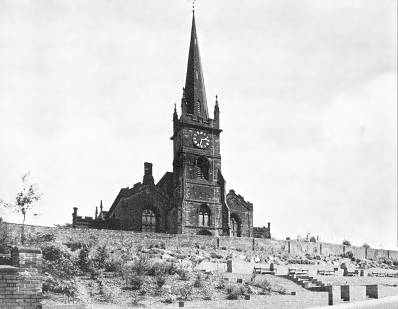
St. Bartholomew's Church from
Ethelfleda Terrace. |
|

St. Bartholomew's Church, as seen
from Church Hill. |
|
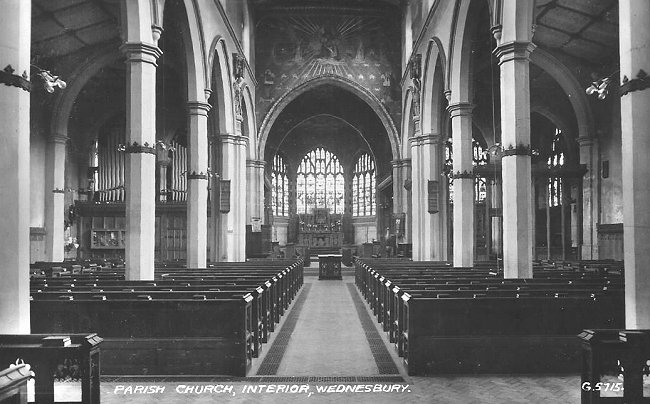
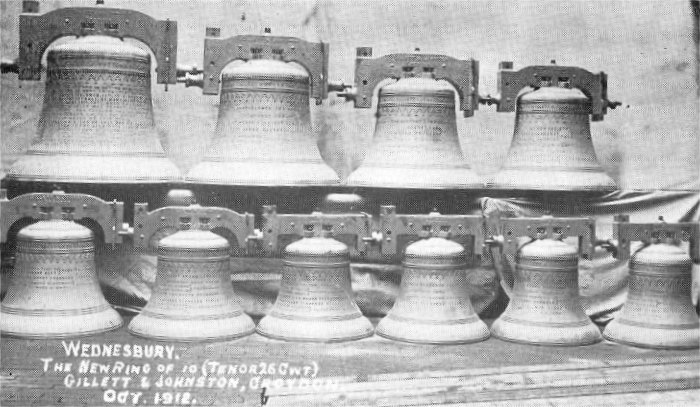
St. Bartholomew's bells.
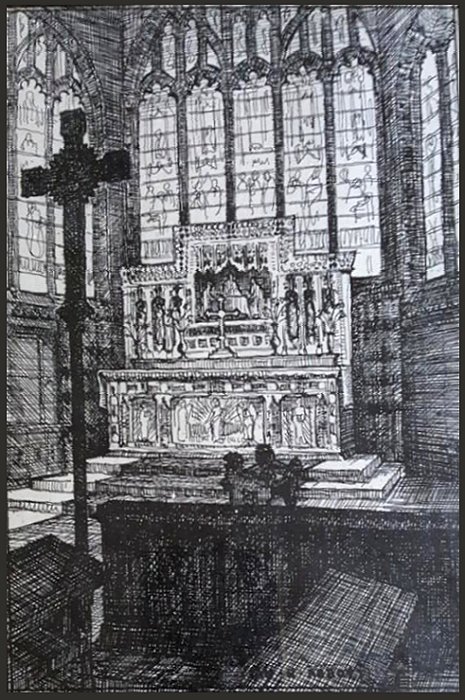 |
A fine pencil
sketch of the church interior, entitled,
'Alter and Reredos, Wednesbury Parish
Church, Ian Abbott 49'.
If you have any
information about Ian Abbott, please
send me
an email. |
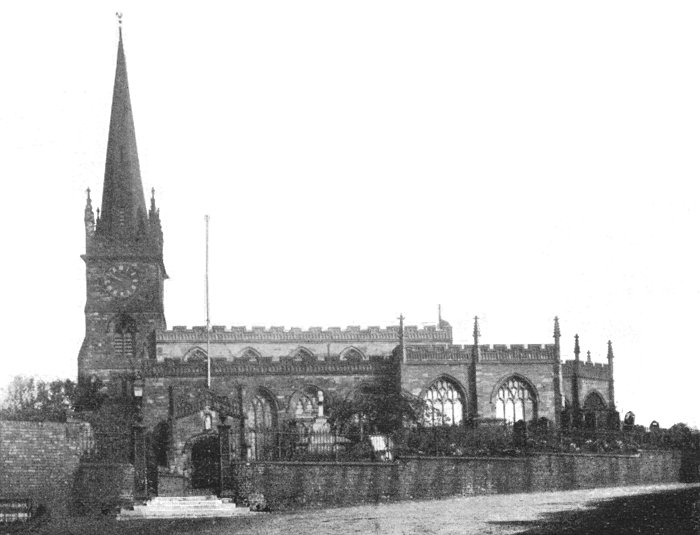
A view of St. Bart's Church from
1908.
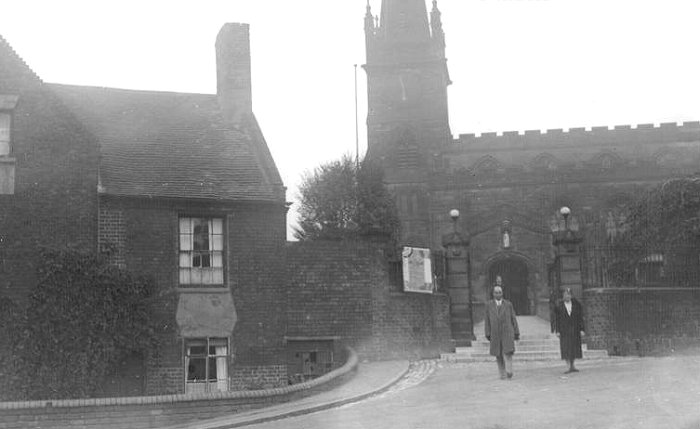
St. Bartholomew's Church, as seen in 1933. From an old
postcard.
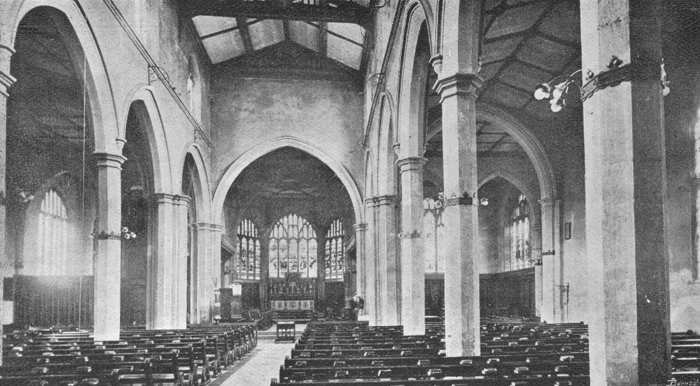
The interior of St. Bart's Church
in 1908.
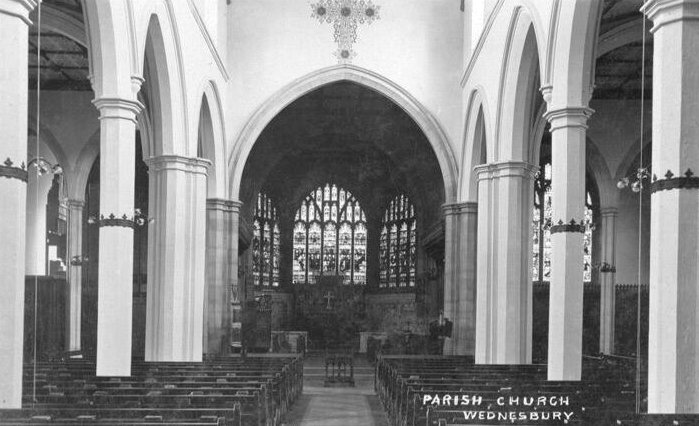
Another view of the interior. From
an old postcard.
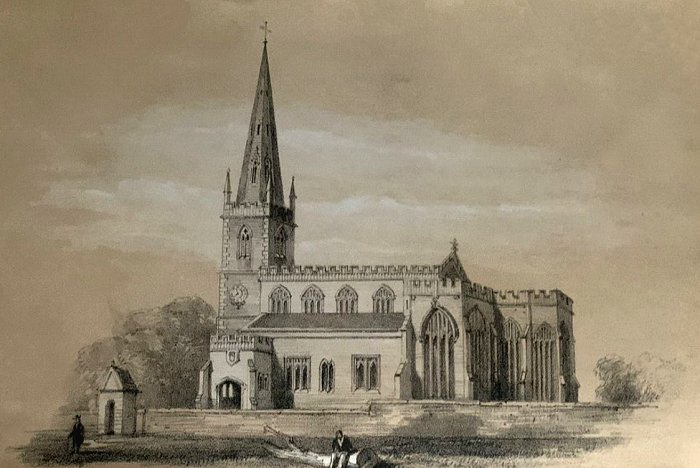
An image of St. Bartholomew's
Church from an 1854 history of Wednesbury.
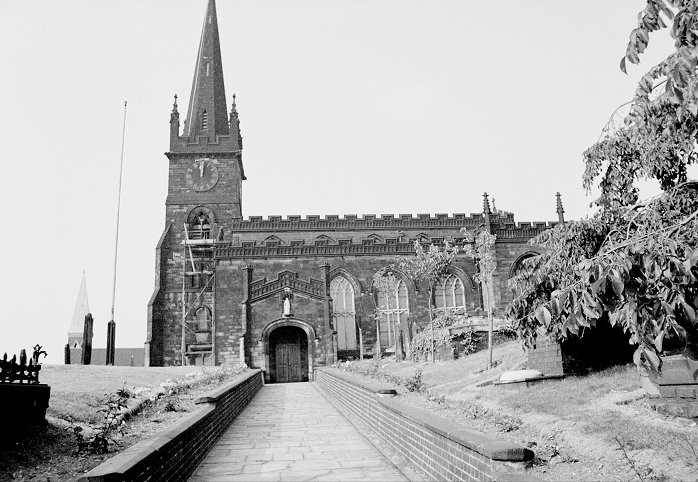
Another view of St. Bartholomew's Church.
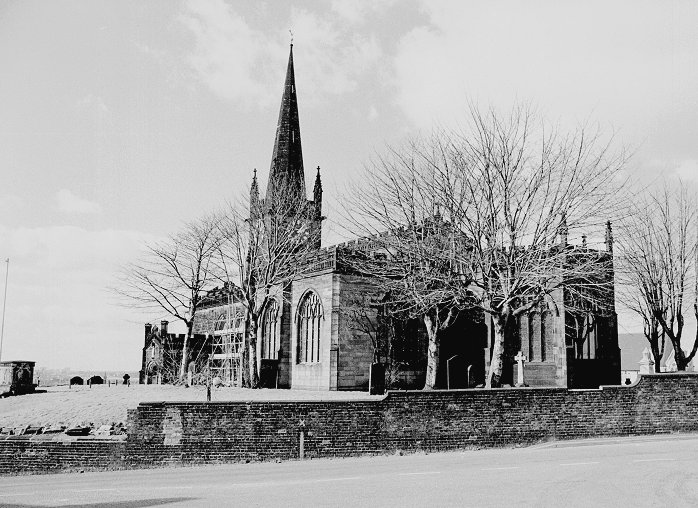
A final view of St. Bartholomew's Church.
St. John’s
Church
In 1843 an Act of Parliament, commonly known as Sir
Robert Peel's Act was passed. Its purpose was to make
better provision for the spiritual care of populous
parishes. The vicar of Wednesbury, the Rev. Isaac
Clarkson took advantage of the act and instigated the
formation of three new ecclesiastical parishes; St.
John's, St. James's, and Moxley, which were created on
3rd June, 1844. The Rev. John Winter was appointed as
the first vicar of the parish of St. John and services
were held in a carpenter’s shop and then in the People’s
Hall. |
|
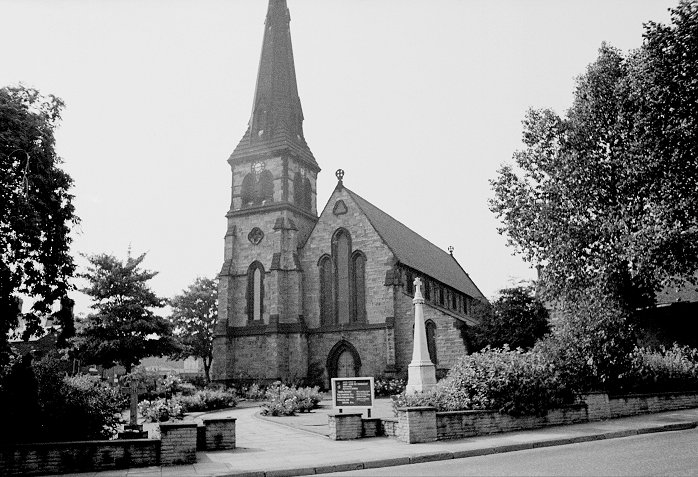
St. John's Church. |
|
Building work on the new church in Lower
High Street began in 1845, supported by Edward Thomas
Foley, Member of Parliament for Herefordshire, and
one-time High Sheriff of Herefordshire. The land was
given by Samuel Addison, along with a gift of £500 for
the building fund, and £700 for the spire. The
foundation stone was laid by Lady Emily Foley on
Thursday 27th March, 1845.
The stone building was built in the early English
style using the local yellow-brown peldon sandstone from Monway Field. The building
consisted of a western chancel, a nave with 6 bays, a
clerestory, aisles, a north porch, and a south-eastern
tower, with a spire and one bell. The architects were
Messrs. Daukes and Hamilton, and the builder was Mr.
Isaac Highway of Walsall. The site and the building cost
£5,758.6s.4d. which was raised with the help of grants
from the Lichfield Diocesan Church Extension Society,
and the Incorporated Society for Building Churches and
Chapels.

St. John's lady choristers in
1905.
|
|
The church seated 1,000
people and was consecrated on 13th May, 1846, by the
Bishop of Lichfield. An organ was presented to the
church by James Bagnall and Thomas Walker, and gas
lighting soon added.
Mrs. Elwell of Wood Green presented
the church with the carpet within the alter rails, Mrs.
Fletcher of Dudley gave the linen for the communion
table, and the books for the minister were presented by
the Society for Promoting Christian Knowledge.
£300 a year was provided for the vicar,
£150 a year was provided by the Ecclesiastical
Commissioners, and other funds came from Wednesbury
Parish tithes. Rents were paid for the pews, which were
given to the vicar, less £6 a year for the church clerk.
The church's patron was Lady Emily Foley. |
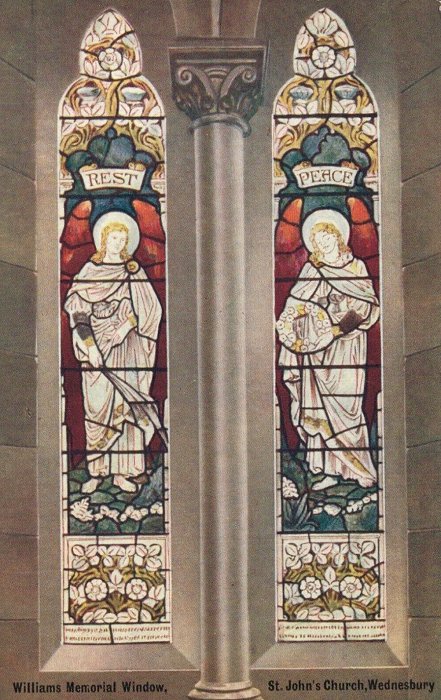
From an old postcard. |
|
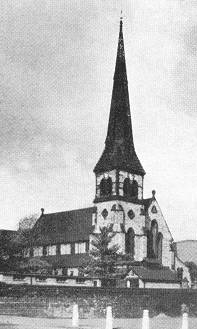
St. John's Church. |
St. John's Parish Schools were built in
1848-1849 at a cost of £1,158.10s.2d., including the
fittings and the site. The school opened on the 11th
March, 1849 and had accommodation for 300 children. It
was both a Sunday and a day school. In the 1850s the
population of the parish was around 2,500.
A parsonage was built in 1893 and stood on part of
the site previously occupied by the Legs of Man Tavern.
At the time the church tower contained the only
illuminated clock in the town and was given by Edward
Smith to commemorate the Queen’s Jubilee. Restoration
work carried out during the church’s golden jubilee in
1896 included the decoration of the interior, the
provision of an organ chamber, and external repair work.
The building became derelict in 1980 and was
demolished in July 1985. |
|
St. James’ Parish was created on
3rd
June, 1844 along with the parish of St. John.
The first
building to be constructed on the site, in St. James
Street was the parish school, which opened in March 1845.
It was built at a cost of £1,126.19s.0d. including the
cost of the land, and the residence for the master and
mistress. Church services were initially held there until the the
opening of the church.
In January 1847 a committee was
formed to oversee the building of the church. The laying
of the foundation stone took place on 26th May, 1847 and the
building was consecrated on Wednesday 31st May,
1848.
The church, built in early English style, with the
same local stone as St. John’s, cost £3,405, and seated
835 people.
The building consists of a nave, aisles, a
chancel with an apse, a vestry, south porch, and a tower
with a clock, chimes and one bell.
|
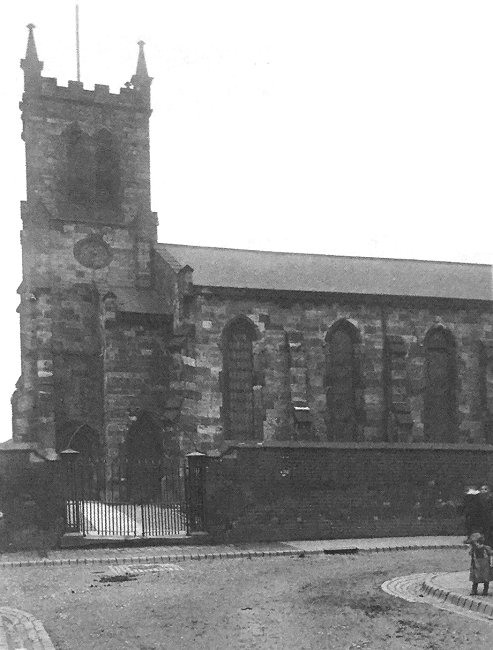
St. James' Church. From an old
postcard. |
|
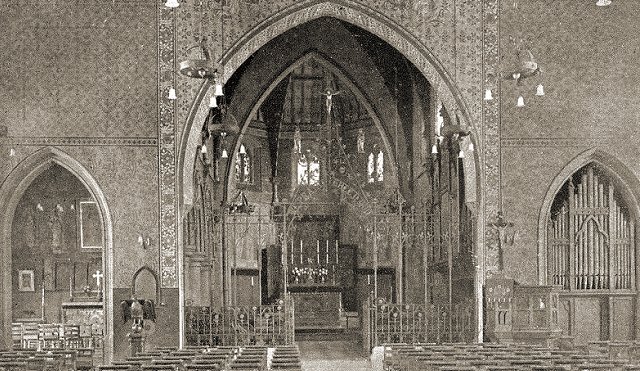
The interior of St. James' Church.
From an old postcard.
In 1855 John Nock Bagnall, one of
the church wardens, became the church’s patron. The
first minister, Joseph
Hall was soon followed by William Graham Cole who took over
on 5th September, 1846. Two years later cholera spread through the town and
claimed 200 victims, more than half of whom lived in the
parish. Cole and his assistant curate bravely entered
victims’ houses when the other occupants had fled,
leaving the victim to die. In 1853 Cole was joined by
assistant curate Richard Twigg who would eventually
become the most influential minister at the church.
Twigg was born in Yorkshire in 1825
and ordained in 1850. He came to Wednesbury after
serving as a curate in Northumberland. He took over
after Cole’s death in 1856 and became known for his
eloquent preaching and his mission services. Through his
efforts at least 30 young men entered the ministry and
more than 1,000 children attended Sunday school. One of
the people whose lives were greatly changed by him was
Dora Pattison, better known in Walsall as Sister Dora,
matron of the Cottage Hospital.
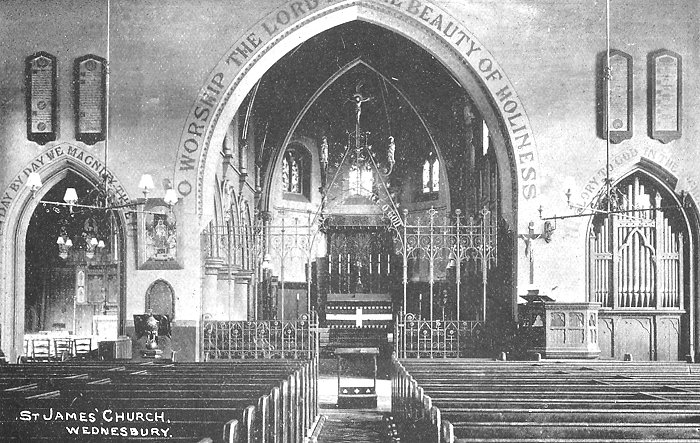
The interior of St. James' Church
in 1905.
Richard Twigg’s wife was equally
enthusiastic and held meetings in some of the local
cottages, which led to the formation of St. Peter’s
Mission Chapel in Meeting Street, which opened in 1872
in two converted cottages. Unfortunately she didn’t live
to see the opening as she died in 1869. Her funeral
service was attended by between 4,000 and 5,000 people,
and she was commemorated by the building of the chancel
apse. Richard Twigg died in 1882.
Other building work included the
addition of two chapels, one in 1887 as a memorial to
John Nock Bagnall, and the second, on the south side of
the chancel, as a memorial to George Silas Guy and
Henrietta Maria Guy.
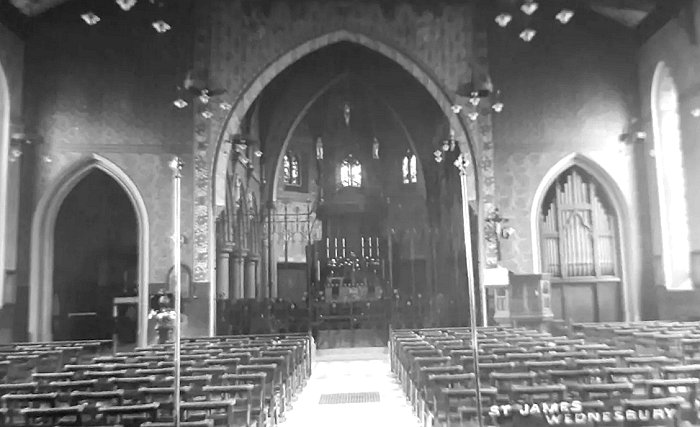
Another view of the interior of St. James' Church.
From an old postcard.
|
|
St. Paul’s
Church, Wood Green
The parish church was built in 1874
of red sandstone in the Decorated style, at a cost of
£5,000 by the Elwell family who ran Wednesbury Forge.
A
spire, clock and a peal of 8 bells were added in 1888.
The church consists of a chancel, nave, aisles,
vestries, north porch and a western tower with the
spire, clock and bells.
Wood Green ecclesiastical parish
was formed on 19th March 1875.
There is a font made of Caen stone
and Irish marble in memory of Mrs. Griffiths of The
Oaks, Wednesbury, a stained east window, which is a
memorial to Edwin Richards, and a west window, presented
by Job Edwards as a memorial to Bishop Selwyn.
Other
additions include a stone reredos, erected in 1903 in
memory of Alfred Elwell, and a wrought iron screen,
erected as a memorial to the Reverend Tuthill, vicar
from 1875-1902.
When the church was built, the
Church of the Good Shepherd, a
chapel of ease at The Delves was transferred to it from
St. Bartholomew’s.
The Church of the
Good Shepherd closed in 1936 when the new ecclesiastical
district of St Gabriel Fullbrook, Walsall was created.
|
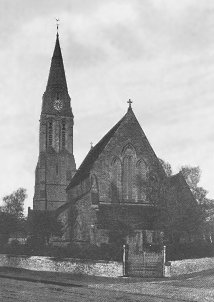
St. Paul's Church. |
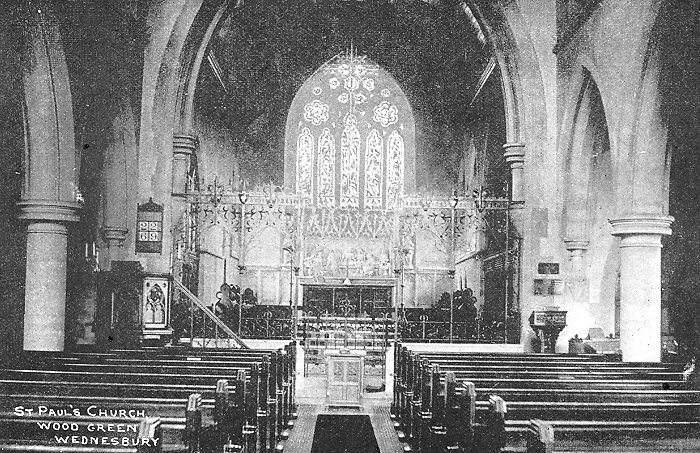
The interior of St. Paul's Church in 1904.
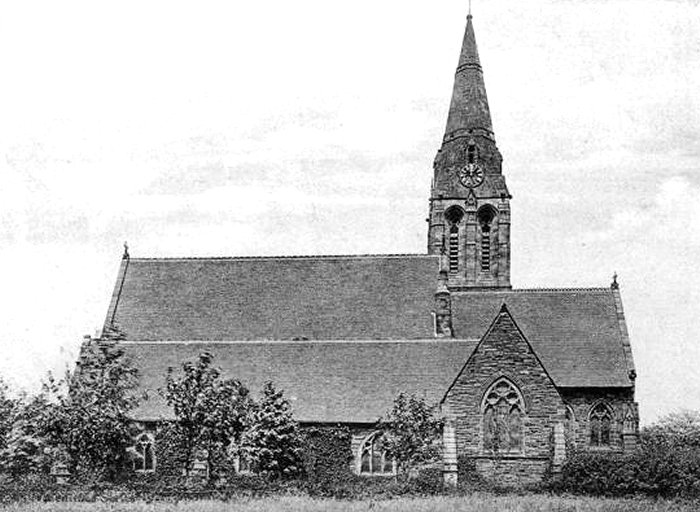
St. Paul's Church. From an old postcard.
|
St. Luke’s
Church, Alma Street, Mesty
Croft
The parish of St. Luke was created
in 1944, and started with St. Luke’s Mission, founded in
1879 in a building originally owned by the Elwell
family, and used as a school for the children of their
workers. In 1884 the building was enlarged and a chancel
added. The church in its final form opened in 1894 and
survived until the 1970s.
St.
Andrew’s Mission Church, Kings Hill |
| The church, built in 1893 to 94,
was built at a cost around £1,700.
In 1903 a small two-manual organ was
added, and paid for by public subscription.
In the same
year the day schools in connection with the church were
enlarged and restored at a cost of £850. |

St. Andrew's Church. |
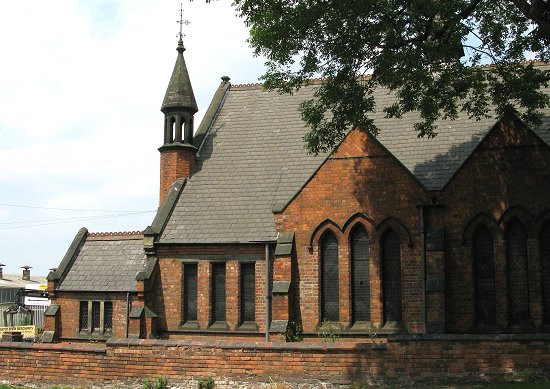 |
A side view of the church from
Kings Hill Park. |
| The church also became Kings Hill Methodist
Church, as can be seen from the notice board opposite. After many years of dereliction, and proposed
demolition, the church will be converted into a
residential property.
|
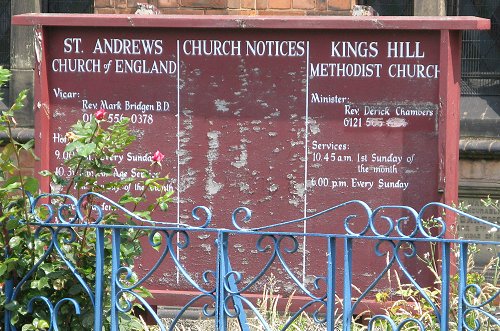 |
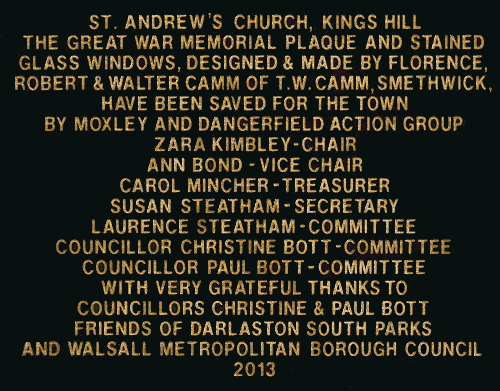 |
The stained glass windows and
memorial plaque from the church are now on permanent
display at Darlaston Town Hall. |
| The stained glass windows at
their new location in Darlaston Town Hall. |
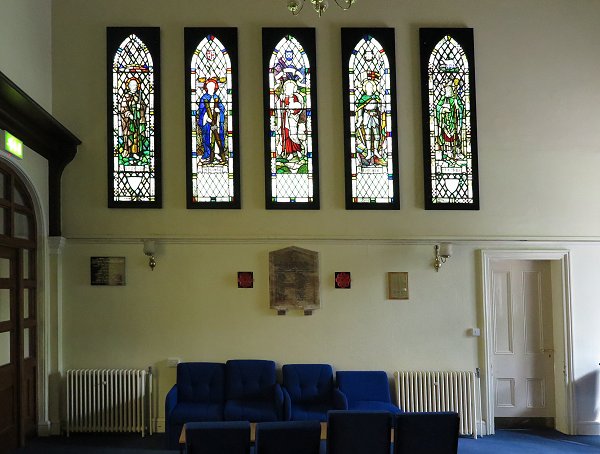 |
 |
The Great War memorial plaque
from St. Andrew's Church.
As seen at Darlaston Town Hall in
2014. |
| The Reverend George Montgomery formed a Roman
Catholic mission at Wednesbury in 1852 and soon had
upwards of 3,000 members. A church was quickly required
and land for the purpose was purchased by Father Crewe
of the Bilston mission.
A small church and the existing
presbytery were soon built, after much opposition from
the Protestants, who talked of destroying it by
purchasing and working the underlying minerals.
|
|
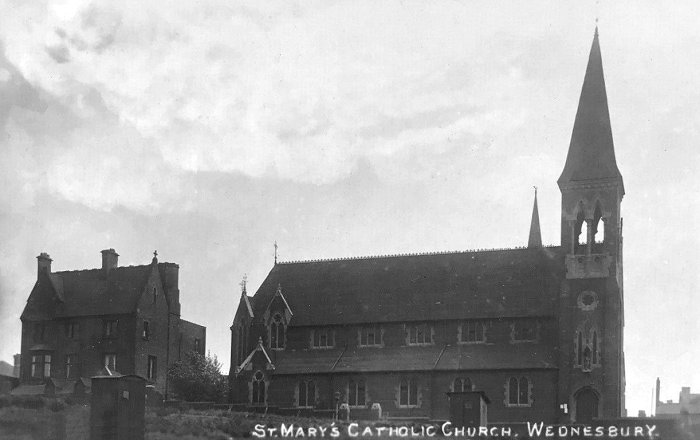
From an old postcard. |
|

St. Mary's Church. |
| Montgomery’s successor Stewart Bathurst found the
original chapel in a bad state of repair and also had
the task of providing a school due to the Education Act
of 1870. As a result he built two schools, one on Church
Hill accommodating 255 children, and another in Portway
Road, accommodating 319. The
existing church was built in 1872 to the designs of Mr.
Gilbert S. Blount of London. It is in early English
style and consists of a nave, aisles, chancel, chapels,
and towers. |
 |
|
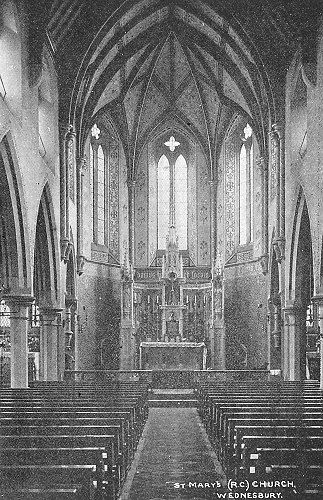 |
|
Two
views of St. Mary's Church. |
|
|
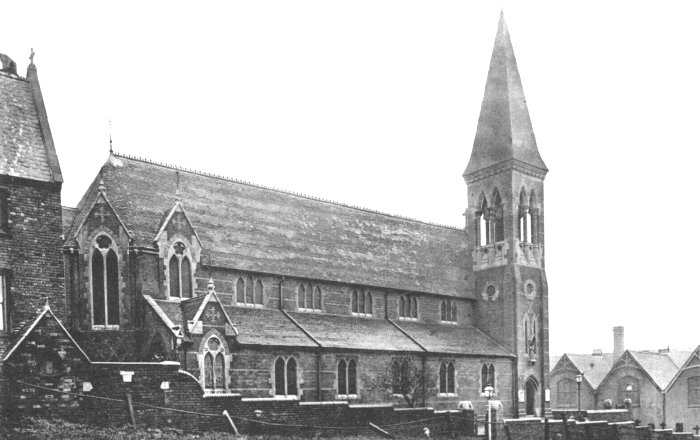
Another view of St. Mary's
Church. From an old postcard. |
|
Methodism
Wednesbury is well remembered for
the riots and anger caused during some of John Wesley’s
visits to the town. His brother Charles Wesley came in
1742 and preached at Holloway Bank, making several
converts who met regularly, and encouraged John Wesley
to come to the town to preach. His first visit took
place on Friday 7th January, 1743 and during
the evening he gave a sermon at the Market Cross
building. The following day he preached 3 times at
Holloway Bank and the number of Wesleyans in the society
reached 29. By the following Tuesday the number of
members had increased to 100.
His next visit in April was very
different due to hostility fuelled by the Parish Church
vicar, Edward Egginton. When he visited again in May the
membership had reached 300 and a march was arranged to
Walsall. During the proceedings a hostile crowd gathered
showing much opposition. By the end of the month things
went from bad to worse when rioting began on 30th
May. During the riot the windows of John Adams’ house in
Darlaston were broken.
|
| As a result Mr. Adams, and the Chief Constable of
Wednesbury, along with prominent Methodist Francis Ward,
the underground manager in John Wood’s colliery, went to
obtain a warrant from the magistrate.
The mob became more hostile and they were stoned. The
magistrate refused to issue a warrant and Francis Ward
was savagely manhandled by the crowd. |
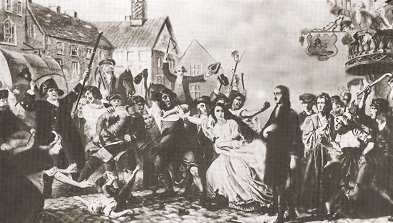
John Wesley greets the Wednesbury
mob. |
|
Three weeks later a crowd from
Wednesbury and Darlaston assembled in Wednesbury
churchyard and proceeded to attack the houses of the
local Methodists. The damage was most extensive in
Darlaston. The disturbances continued for the next 8 or
9 months and Wesley recorded his thoughts on the matter
in his journal on 18th February, 1744:
“Ever since the 20th of
last June the mob of Walsall, Darlaston and Wednesbury,
hired for that purpose by their betters, have broken
open their poorer neighbour’s houses at their pleasure
by night and by day; extorted money from the few that
had it; took away or destroyed their victuals and goods;
beat and wounded their bodies; threatened their lives;
abused their women (some in a manner too terrible to
name) and openly declared they would destroy every
Methodist in the country – the Christian country where
His Majesty’s innocent and loyal subjects have been so
treated for eight months and are now by their wanton
persecutors publicly branded for rioters and
incendiaries.”
He briefly visited Wednesbury on
22nd
June, but did not appear publicly. His next visit
however would be very different. At midday on 20th
October, 1743 he preached from the now famous “horse
block” at the High Bullen (in reality a flight of steps
leading to the upper floor of a malt house) without
incident. He then went to Francis Ward’s cottage and
while he was there the mob arrived, but soon moved on.
He now felt it was time to leave, but was persuaded not
to do so.
By 5 o’clock the mob returned and
surrounded the cottage with cries of “Bring out the
minister!” The mob’s leader entered the cottage to see
Wesley and soon quietened down. Wesley then went out to
talk to the crowd who asked him to go with them to see
the magistrate at Bentley Hall. He consented to do so
and along with some of his colleagues and the crowd of
300 or so they proceeded to see Mr. Lane at Bentley
Hall. Mr. Lane told them to go home and be quiet, but
this was not good enough for the crowd who then escorted
Wesley to see another magistrate, Mr. Persehouse in
Walsall. Mr. Persehouse had retired for the night and so
the crowd decided to go home. At this point they were
attacked by a mob from Walsall, into whose hands Wesley
fell. His captors were very hostile and while they were
deciding what to do next, Wesley began to pray aloud.
The leader of the mob was so moved by his words that he
had a change of heart and they let Wesley and his
friends go. That night they returned to Wednesbury after
having a lucky escape.
In November violence broke out in
West Bromwich, and later in Darlaston after Vicar
Egginton’s visit. He got the town crier, Thomas Winsper
to announce that the Methodists must come to the Crown
Inn and sign a recantation or expect to have their
houses pulled down. This threat was the start of the
events that took place in Darlaston during the following
January and February. On 13th, 14th, and 23rd January a
great mob gathered in Darlaston and fell upon several
people who were going to Wednesbury and also on the wife
of John Constable of Darlaston. Constable obtained a
warrant against the offenders for criminal assault on
his wife, but only one person was arrested. When he was
brought before the magistrate, the magistrate declined
to act. As a result the mob sacked Constable’s house on
the 30th
of the month and he and his wife took refuge with a
friend. The mob then threatened the friend’s house and
so the Constables were forced to flee.
The next day a mob assembled at
Church Hill, Wednesbury but left after hearing that some
of the Methodists were preparing to defend themselves.
Wesley himself came to the town and preached the next
day without incident. He stayed until the morning of
Monday 6th February and was accompanied on
the first part of his journey by James Jones a fellow
Methodist preacher. On Jones’ return he found his fellow
Methodists in prayer, having heard that a mob would
arrive the next day from Darlaston and elsewhere
to plunder the house of every Methodist in the town.
At 8 o’clock the next morning Jones
addressed his fellow Methodists, and as he was doing so
the news came that the mob had already entered the town
and had began to break into the houses. Jones himself
went into hiding and left for Birmingham early the next
day. The mob entered each of the leading Methodist’s
houses, breaking windows and window frames, smashing
everything inside and generally wrecking the place.
Anything of value was taken away. No resistance was
offered and most people fled, only some of the children
remained, not knowing what to do.
The mob’s ring leaders threatened
to sack any of their employees who did not join them in
the riot and offered to cease rioting if the members of
the Methodist society would sign an undertaking to never
invite or receive Methodist preachers again. They did
not receive a single signature.
The next day similar outrages were
carried out at Aldridge, but this time the returning mob
was relieved of their spoils by a group of responsible
citizens who took the goods to the Town Hall and invited
the owners to come and collect them. Some of the victims
unsuccessfully attempted to obtain a warrant against the
principal rioters, but none of the local magistrates
would comply.
Wesley stated that 33 people had
suffered damage to their property with an estimated loss
of over £500. F.W. Hackwood suggests that 13 of the
victims lived in Wednesbury and that their losses
amounted to £325.16s.6d. The disturbances which were not
confined to this area where clearly well planned and
organised beforehand. Some members of the mob were
forced to participate by their employers and others may
have taken part in order to steal goods from the houses.
Things began to quiet down, and
although Wesley visited and preached in the town on
several later occasions, it all went off peacefully. On
15th
March, 1761 he preached before a crowd of between 8,000
and 10,000 people in Monway Field. The rise of Methodism
in the town greatly benefited from the increase in
population due to the industrial expansion in the area.
Meeting Street is named after the Wesleyan Chapel that
was built there in 1760 and remained in use until 1813.
|

St. Mary's and St. Bartholomew's on Church
Hill.
|
Spring
Head Wesleyan Church
The church was built in 1867 on the
site of the old Methodist chapel from 1760 and could
seat about 1,100 people. In front of the church stood
the old “horse block” from the High Bullen on which
Wesley used to preach. There were also two large church
schools, originally built in 1847. They were modernised
in 1886 at a cost of about £1,500 and could accommodate
nearly 600 children. The church was rebuilt in 1932, and
demolished in 1965, only two years short of its
centenary.
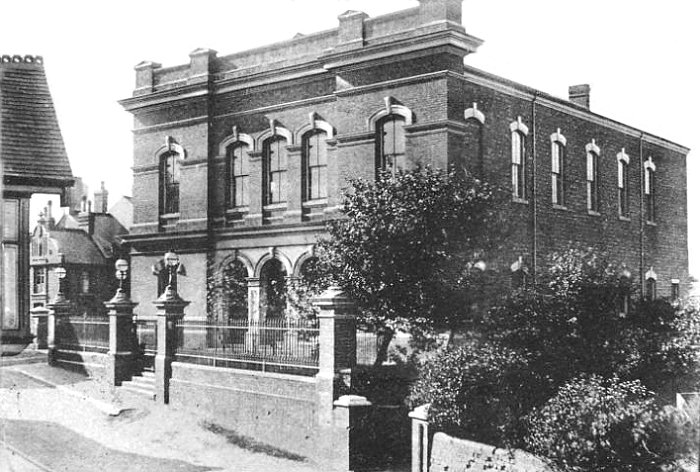
Spring Head Wesleyan Church.

Spring Head Wesleyan Church
interior.
A Primitive Methodist chapel opened
in Camp Street in 1824 to accommodate 500 people,
followed by 5 others between 1850 and 1873. By the 1960s
there were 7 Methodist chapels the town:
Spring Head, Riddings Lane, Camp
Street, Elwell Street, Vicar Street,
Joynson Street, and Old Park Road.

Old Park Road Primitive Methodist Church.
Trinity
Congregational Church, Walsall Street
|
|

The later church. |
In 1761 the Congregationalists
purchased land on Holyhead Road and built a chapel which
opened in 1762.
In 1848 to 1850 they built a chapel in
Russell Street which flourished for 20 or 30 years.
By
the end of the century it was in decline, but fortunes
soon changed and attendances began to increase, so much
so that in 1904 Trinity Congregational Church was built
in Walsall Street at a cost of £4,300.
The church opened
in 1905 and could seat 600 people. |
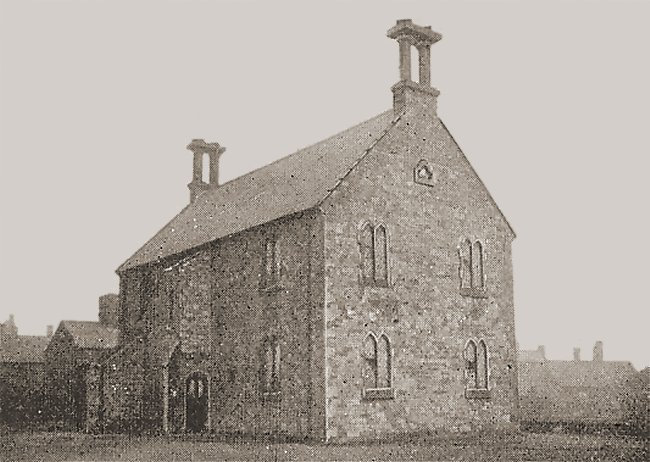
The chapel in Russell Street.
|
Baptist
Church, Holyhead Road
The first Baptist congregation in
the town met in the old Quaker meeting house in 1834 and
then from 1838 in a chapel in Dudley Street. In 1848
they purchased the ex Congregationalist’s chapel in
Holyhead Road. Attendances dwindled and two years later
they had to leave, some members returning to the Dudley
Street chapel.
By 1856 their fortunes revived and
they returned to the chapel in Holyhead Road, now known
as Aenon Chapel.
Salvationists
The Salvation Army started in 1878
and reached Wednesbury in 1879. They began meeting in
one of the old Methodist chapels in Holyhead Road and
then in 1882 moved to the Theatre Royal in Earp’s Lane.
In 1905 they moved to Upper High Street and opened a
second barracks in Crankhall Lane.

Church Hill.
|
 |
|
 |
|
 |
Return to the
16th Century |
|
Return to
the contents |
|
Proceed to
Early Industries |
|